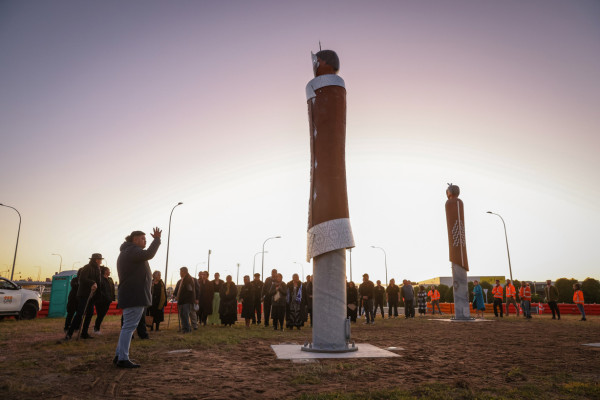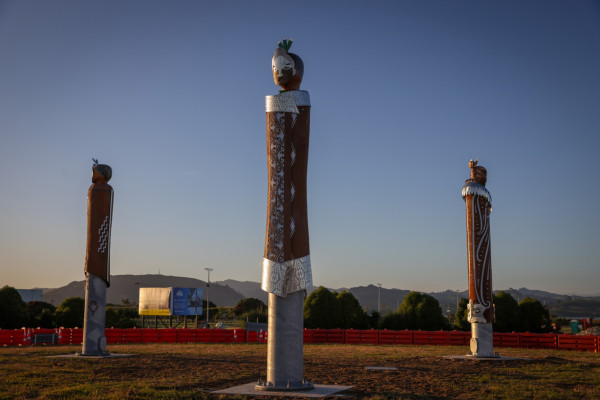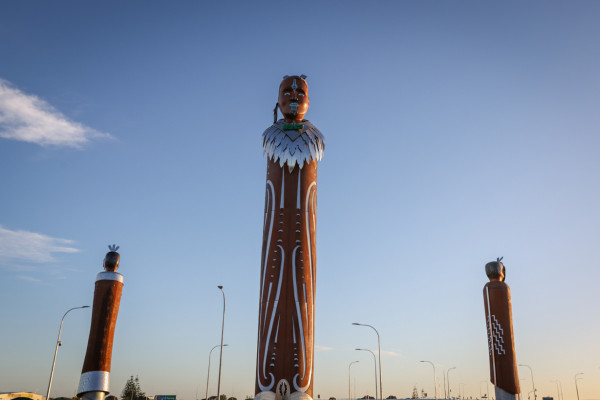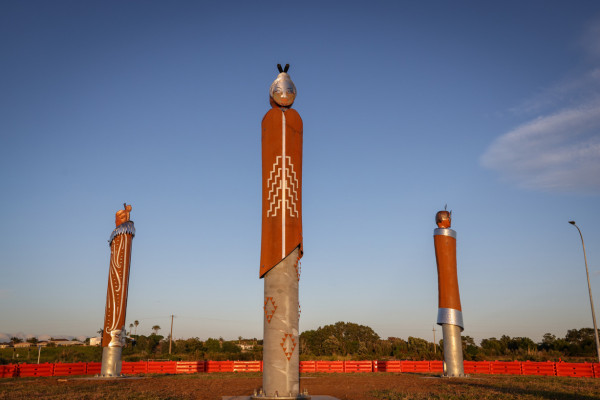People of Tauranga and visitors to the city are now being welcomed by 3 striking pou whenua, representing 3 of the city’s tupuna wāhine/female ancestors.
“A karanga is steeped in tikanga and symbolises the mana wāhine, the power of women within the marae. It is a spiritual call that has been heard through generations of whānau across the country. Now three tupuna wāhine are the first to welcome manuhiri/visitors to Tauranga Moana.”
The new gateway to Tauranga was blessed by local hapū Ngāi Tukairangi, Ngāti Tapu and Ngā Pōtiki and unveiled by the rising sun on Friday, welcoming them into their final place, the new State Highway 29A roundabout.

The pou whenua represent wāhine Te-Aho-o-te-Rangi of Ngāi Tukairangi, Kahumoeangi of Ngāti Tapu and Parewaitai of Ngā Pōtiki and were designed as part of the Baypark to Bayfair Link project. They were created by local artists Linda Munn, Stu McDonald and Maraea Timutimu, supported by steel fabricators Longveld and carved by local kaiwhakairo/carvers led by Stu McDonald.
Jo Wilton, NZ Transport Agency Waka Kotahi Regional Manager Infrastructure Delivery for Waikato and Bay of Plenty, says the blessing and unveiling of the pou whenua was a special way to mark the importance of the relationship with mana whenua.
“Coming together is also a celebration of our partnership with mana whenua and our commitment to link our works with the history, the stories and people of Tauranga Moana.
“It’s been a real team effort and I’d like to thank Ngāi Tukairangi, Ngāti Tapu and Ngā Pōtiki, the artists, our contractors and NZTA staff for making it happen.”
“The pou whenua will be joined by other mahi toi/artworks and urban design elements already in place along the project site. They identify key locations, recognising the cultural identity and values of mana whenua, by acknowledging and expressing traditions and relationships with ancestral lands, water, sites, wāhi tapu and other taonga that is an integral part of the project.
Puhirake Ihaka of Ngāti Tapu also acknowledges the strong relationship developed between the 3 hapū and Waka Kotahi since the beginning of the project.
“Through our coming together we ensure that the project reflects tikanga and achieves mutually beneficial outcomes that we can all be proud of,” Puhirake Ihaka says.
“It’s been a long and rewarding journey and it’s moving to see the 3 pou whenua in their final place. So much work went into this project and I would like to thank everyone who was involved. It’s a special occasion for all of us.
“A lot of people will travel through this location and the 3 female ancestors will give them a metaphorical karanga, that first call of welcome before they travel through this area.
“All 3 lived on the estuary surrounding the roundabout – the location where they are now placed, each looking over their iconic landmarks Mauao, Pāpāmoa Hills, Rangataua and Te Awanui (Tauranga harbour) as the kaitiaki of the area.
“Seeing these tupuna wāhine means a lot to us. Not many of our kuia have been carved in places where you’d traditionally see carvings of male figures. We really wanted to give our tupuna wāhine visibility, honouring the important role they played and continue playing in our society.”
The 3 pou whenua have been designed as part of the Baypark to Bayfair Link project and reflect the values and historical significance of the area. They are connected through whakapapa of the 3 neighbouring hapū and are looking out to their respective marae.
Each pou whenua stands 6 metres tall, on a central column, and is constructed using a combination of stainless, corten and galvanised steel and carved timber. They are adorned with corten steel korowai/cloak and other taonga/treasures, and the complex designs have been fabricated by metal fabricators Longveld and the busts carved by local kaiwhakairo/carvers led by Stu McDonald.
These 3 figures represent several important elements for the local hapū including the patterns and symbols they bear, the combined strength of the 3 hapū and the significant role wāhine had and still have in society. They stand as the predominant marker and mahi toi at the southern end of the Baypark to Bayfair Link project.
Located in the middle of the SH29A roundabout, there is no access to the artwork. People will be able to read about the artwork on storyboards at SH2/29A Te Maunga interchange.

Te-Aho-o-te-Rangi is the tupuna wahine, wife of Koraurau and mother of Hohepa Hikutaia. She made the ultimate sacrifice when crossing the moana between Otamataha and Whareroa in order to save her son in 1828. This is symbolised in her heart shaped taonga and her moana inspired kowhaiwhai border. Additionally, her triangle and taaniko patterned collar and hem are patterns seen in both marae at Hungahungatoroa and Whareroa.
Te-Aho-o-te-Rangi along with other Ngāi Tukairangi tupuna wāhine feature in the mōteatea Te tauaarai which was the first source of inspiration for this pou. Te-Aho-o-te-Rangi stands proudly and embodies her name connecting us to the sky and to our history.

Kahumoeangi was one of the Ngāti Tapu matriarchs, a high ranking chieftainess. Ngāti Tapu is named after her son Tapukino and two figures at the bottom of the pou represent her son and her husband. The collar piece features feathers, a notion back to her name Kahu – after the harrier hawk. It speaks about the presence of this kuia when you’re in your dreams, in a state of rest where she’s always floating above you.
The pattern on the korowai represents movement and about being present amongst our people and the people who drive past this area.

Parewaitai is the name of two important Ngā Pōtiki tupuna. The first Parewaitai is the daughter of Tamapahore, the founding chief of the Ngā Pōtiki iwi and its 12 hapū. Tamapahore is of historical significance for Tauranga Moana and Ngā Pōtiki during the time of Te Heke o Mataatua.
The second Parewaitai was a Ngā Pōtiki tupuna who was one of four kuia taken captive in 1836 and repatriated to Tauranga Moana in the 1860s.
The pou whenua for Parewaitai is designed around cultural elements that are found at Tahuwhakatiki Marae and represents a Poutama design found at the whare. Poutama talks about the journey of attaining knowledge and elevating others to do the same as well. The bottom of the pou features the design of a pāpaka – one of the many kaitiaki of Ngā Pōtiki, especially te tāhuna o Rangataua.
Maraea is a visual artist and teacher whose portfolio spans a range of mediums and platforms. She has had numerous pieces in prominent art exhibitions across Aotearoa, with a practice backed by years of practical, theoretical, and experimental knowledge. Maraea emphasises the importance of Te Ao Māori (Māori world view) in her mahi, expertly weaving whakapapa, process and meaning in all her mahi toi.
Stu is a tā moko (traditional Māori tattoo) artist, teacher and carver by study and trade. He has a prominent local Tauranga Moana based studio – The Ahipoutu Collective, and a team of creatives around him creating beautiful pieces for people and places around Aotearoa and internationally. Stu also shares his knowledge in education, mental health and wellbeing working with local schools in Tauranga Moana and the broader Bay of Plenty.
Stu’s traditional knowledge of tā moko and whakairo (carving), and general skill as a creative and artist, has led to a broad range of project experience, with the Bay Link project providing a great opportunity to work with different scales and mediums.
Linda’s multidisciplinary art practice reinforces principles of tino rangatiratanga (Māori self-determination). She uses ancestral knowledge to explore the metaphysical and the place of spirituality in Māori cultural life. In 1989, with Hiraina Marsden and Jan Dobson, she designed the Tino Rangatiratanga flag as a way of unifying Māori concerns about the 1990 celebrations commemorating 150 years of Māori and Pākehā relations. Today, the Tino Rangatiratanga flag is mandated as the national Māori flag and is a symbol of Māori resistance and resilience.
A series of unique yet connected mahi toi are being developed as part of the Bay Link project. Each uses the talent, craft and traditional knowledge held by Tauranga Moana multidisciplinary artists Linda Munn, Maraea Timutimu and Stu McDonald.
The works are being developed through an iterative process with advisory group members, artists and the broader project team. The tangata whenua working group meet monthly to discuss construction updates, community concerns, urban and landscape design updates to ensure all elements of the project, including cultural considerations are progressing with integrity.
This process of collaboration has resulted in a number of carvings, sculptures, pou whenua and markers, designed to reflect the values and historical significance of the area. These elements will begin to be unveiled as construction progresses.